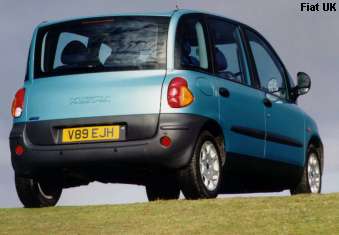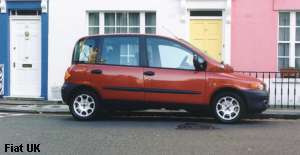
|
|

|
NEWcars: 2000 Fiat Multipla, 11 December 1999 |

|
|
STYLE But a single glance at the new Multipla confirms Fiat's assertion that this MPV is a radical advance in automotive styling. There is simply nothing like it on the roads today - and its innovative design has been heralded as a major breakthrough. Already the Multipla has been on display - to unbridled acclaim - at the Design Museums of London and New York. |

|
|
Multipla at the front The front also highlights Multipla's Twin Module design. The lower section is almost conventional in its streamlining and the way it contains the dipped headlights and indicators in traditional positions either side of the bonnet. A black bumper is then integrated into the front spoiler to form an impact-resistant plastic nose section, which also contains the foglights. However, what really sets the Multipla apart from every other vehicle is the upper section, which appears to have been placed onto the lower one like an additional layer. This has been done deliberately in order to avoid the waste of precious space that normally occurs where the windscreen and the bonnet join together. |
|

|
A striking feature that further distinguishes the Multipla is the location of its main beam headlights. These are set at waist height (in the upper level) to optimise efficiency and improve night-time visibility.
Multipla in profile |
|||||||||||||||||||||||||||||||||||
|
For a vehicle with such an incredibly large interior volume, the Multipla's length (it's 4 cm shorter than a Fiat Bravo) comes as a surprise. The large amount of room behind the C pillar is also remarkable, indicating a considerable amount of space for luggage. The waistline is slightly tilted towards the front, accentuating the separation between the two modules and giving the car a forward, thrusting appearance. Chunky, durable, black side-rubbing strips protect the doors, matching the door handles, pillars and door mirrors. The door handle surrounds incorporate special black plastic lips that further guard against damage when the doors are opened. The door mirrors are unique in being split into two sections so that the driver can see not only what's immediately behind but also monitor the kerb when reversing. Being such a wide vehicle, they fold flat in order to gain access to narrow spaces.
Multipla at the rear The whole rear section evokes a chic 'retro' feel. In order to maximise its load carrying potential, the rear of the Multipla seems to bulge outwards, both at the top and at the bottom. The cargo door opens high on gas-filled struts to reveal a cavernous aperture and a low deck height, which facilitate loading. Here again, the Multipla's wide body also pays dividends. A rear wash/wipe facility is standard on all models, along with a very high third brake light. Down below, the black plastic bumper section matches up visually with that at the front and contains the two rear reflectors.
Dimensions
Why is Multipla so tall? |
||||||||||||||||||||||||||||||||||||
|
This has come about as a result of research into the way families use their vehicles nowadays. A large part of the popularity of the MPV stems from its immense versatility and practicality in being not just a means of transport to get a family where it's going, but also a 'home-from-home' when it gets there. Today, the family car is a place in which meals are eaten, games are played, nappies are changed, swimming costumes are put on and sporting equipment is assembled. When they reach their destinations, people get in and out of cars, swap seats, pass things to each other and generally move about a lot: activities that are constrained within normal saloons or estate cars with their low roof-lines. |

|
|
Fiat's designers were also mindful that many families consist of older people - grandparents who find bending down into ordinary cars an awkward business. The tall Multipla provides a light, airy and spacious environment in which all manner of activities are catered for. |
|

| [This Week] [Full Contents] [News] [Features] [Car of the Week] [Motorsport] [A-Z] |